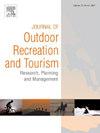To develop or to be abandoned again? Tourism spatial quality assessment of brownfield landscape regeneration: A case study of Xi'an Banpo International Art Park, China
IF 4.4
3区 管理学
Q1 HOSPITALITY, LEISURE, SPORT & TOURISM
Journal of Outdoor Recreation and Tourism-Research Planning and Management
Pub Date : 2025-07-29
DOI:10.1016/j.jort.2025.100933
引用次数: 0
Abstract
Brownfield spatial landscape regeneration is an important direction to cope with urban land use conflicts, and it is an important outdoor tourism carrier that displays the historical characteristics of the city. However, the existing brownfield regeneration space generally suffers from the double dilemma of quality fault and feature dissolution, which leads to the risk of spatial vitality decay and secondary abandonment. This research innovatively constructs a comprehensive evaluation system for the regeneration quality of brownfield landscapes. By integrating fuzzy mathematics and the Analytic Hierarchy Process (FAHP), it breaks through the limitations of traditional single-dimension assessment and, for the first time, incorporates several interdisciplinary indicators, such as spatial resilience, cultural legibility, and industry coupling, into the assessment framework. Taking Xi'an Banpo International Art Park as the empirical object, the research finds that its comprehensive index of regeneration quality is 79.19 (Acceptable), especially in the dimensions of business form (0.84), online and offline information dissemination (0.99, 0.91), and regional cultural self-confidence (1.45), revealing a significant shortcoming. This study calls for the construction of a "culture-technology-governance" triadic theoretical framework and proposes a "spatial gene restoration-industrial entropy regulation-digital brand symbiosis" optimization strategy, which forms a "visitor-community-manager" triadic synergy mechanism and makes up for the inadequacy of the existing brownfield regeneration theory in dynamic adaptation research. This assessment system not only provides a relocatable decision-making tool for urban regeneration but also reveals the non-linear evolution law of industrial heritage tourism space regeneration, which is of theoretical construction value for the establishment of brownfield regeneration assessment standards with Chinese characteristics and provides new ideas for the transformation of industrial heritage in global countries.
Management implications
- 1.Through the adaptive and innovative FAHP, we constructed a comprehensive evaluation system for the spatial quality of brownfield tourism, quantitatively analyzed multiple driving factors such as physical environment, cultural readability, and industry coupling, and provided new ideas and decision-making tools for urban planning managers.
- 2.Xi'an Banpo International Art Park's advantages include physical, functional, and cultural factors, while its disadvantageous factors focus on emotional and informational factors; managers need to adopt the strategy of "making good use of strengths and compensating for weaknesses": strengthening the extraction of cultural IP symbols and implanting intelligent navigation systems to activate the vitality of the space.
- 3.To address the dynamic complexity of brownfield regeneration, a synergistic optimization path of “culture-technology-governance” is proposed.
- 4.The strategy model proposed in this research is not only applicable to Xi'an Banpo Park but can also be extended to similar industrial heritage brownfield sites: reduce the risk of functional homogenization through "entropy value regulation," enhance the cultural radiance through "digital brand symbiosis," and finally realize the sustainable transformation of brownfield sites from "negative urban assets" to "new cultural and tourism landmarks." ultimately realizing the sustainable transformation of brownfield sites from "negative urban assets" to "new landmarks of culture and tourism."
发展还是再次被抛弃?棕地景观再生的旅游空间质量评价——以西安半坡国际艺术公园为例
棕地空间景观再生是应对城市土地利用冲突的重要方向,是展现城市历史特色的重要户外旅游载体。然而,现有棕地再生空间普遍存在质量断层和特征消解的双重困境,存在空间活力衰减和二次废弃的风险。本研究创新性地构建了棕地景观更新质量的综合评价体系。通过将模糊数学与层次分析法(FAHP)相结合,突破了传统单一维度评价的局限性,首次将空间弹性、文化易读性、产业耦合等多学科指标纳入评价框架。以西安半坡国际艺术公园为实证对象,研究发现其再生质量综合指数为79.19(可接受),尤其是在业态(0.84)、线上线下信息传播(0.99)、区域文化自信(1.45)三个维度上,存在明显不足。本研究呼吁构建“文化-技术-治理”三元理论框架,提出“空间基因修复-产业熵调节-数字品牌共生”优化策略,形成“游客-社区-管理者”三元协同机制,弥补现有棕地再生理论在动态适应研究中的不足。该评价体系不仅为城市更新提供了可定位的决策工具,而且揭示了工业遗产旅游空间更新的非线性演化规律,对建立具有中国特色的棕地更新评价标准具有理论建构价值,也为全球各国工业遗产改造提供了新思路。管理implications1。通过适应性创新FAHP,构建棕地旅游空间质量综合评价体系,定量分析棕地旅游自然环境、文化可读性、产业耦合等多重驱动因素,为城市规划管理者提供新的思路和决策工具。西安半坡国际艺术公园的优势因素包括物理因素、功能因素和文化因素,劣势因素主要是情感因素和信息因素;管理者需要采取“扬长补短”的策略:加强文化IP符号的提取,植入智能导航系统,激活空间的活力。针对棕地再生的动态复杂性,提出了“文化-技术-治理”协同优化路径。本研究提出的策略模型不仅适用于西安半坡公园,也可以推广到类似的工业遗产棕地:通过“熵值调节”降低功能同质化风险,通过“数字品牌共生”提升文化辐射,最终实现棕地从“城市负资产”到“文化旅游新地标”的可持续转型,最终实现棕地从“城市负资产”到“文化旅游新地标”的可持续转型。
本文章由计算机程序翻译,如有差异,请以英文原文为准。
求助全文
约1分钟内获得全文
求助全文
来源期刊

Journal of Outdoor Recreation and Tourism-Research Planning and Management
HOSPITALITY, LEISURE, SPORT & TOURISM-
CiteScore
6.70
自引率
5.30%
发文量
84
期刊介绍:
Journal of Outdoor Recreation and Tourism offers a dedicated outlet for research relevant to social sciences and natural resources. The journal publishes peer reviewed original research on all aspects of outdoor recreation planning and management, covering the entire spectrum of settings from wilderness to urban outdoor recreation opportunities. It also focuses on new products and findings in nature based tourism and park management. JORT is an interdisciplinary and transdisciplinary journal, articles may focus on any aspect of theory, method, or concept of outdoor recreation research, planning or management, and interdisciplinary work is especially welcome, and may be of a theoretical and/or a case study nature. Depending on the topic of investigation, articles may be positioned within one academic discipline, or draw from several disciplines in an integrative manner, with overarching relevance to social sciences and natural resources. JORT is international in scope and attracts scholars from all reaches of the world to facilitate the exchange of ideas. As such, the journal enhances understanding of scientific knowledge, empirical results, and practitioners'' needs. Therefore in JORT each article is accompanied by an executive summary, written by the editors or authors, highlighting the planning and management relevant aspects of the article.
 求助内容:
求助内容: 应助结果提醒方式:
应助结果提醒方式:


